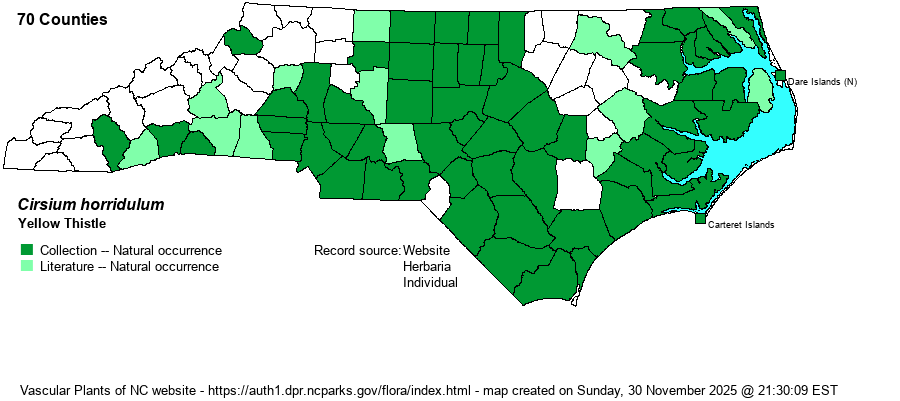| Author | Michaux | |
| Distribution | From the outer Coastal Plain to the western Piedmont; scattered in the low Mountains. The large gap in the northwestern Coastal Plain and northeastern Piedmont is probably due to a lack of collecting.
Southern ME, to FL and TX. Mostly Coastal Plain and Piedmont but scattered farther inland. | |
| Abundance | Common in the eastern half of the Coastal Plain, and west through the Sandhills region. Fairly common to common in the eastern 2/3rds of the Piedmont. Rare in the Mountains and foothills. Scarcity of records in the northwestern Coastal Plain and northeastern Piedmont is puzzling; certainly uncommon there. | |
| Habitat | Dry sandy soils of pine-oak woodlands, openings in woodlands, pine savannas, roadsides, powerlines, and rocky open slopes. Mostly in disturbed habitats. | |
| Phenology | Flowers and fruits late March - early June. | |
| Identification | Uniquely among our thistles, this species has long, broad, leaflike inflorsecence bracts, and which are armed with long yellowish spines. Leaves and stems are also densely spiny, making this a no-go zone! Plants come in two flower morphs, dull yellow or red-maroon. This is the most often seen thistle in the Piedmont, a familiar species in most areas there. | |
| Taxonomic Comments | RAB (1968) named this species as Carduus spinosissimus. Weakley (2018) lists two varieties in NC -- var. horridulum and the rather rare var. vittatum. The former C. smallii has been included within C. horridulum, as C. horridulum var. vittatum.
| |
| Other Common Name(s) | Bristle Thistle, Horrid Thistle, Bull Thistle (the usual common name of the exotic C. vulgare) | |
| State Rank | S5 | |
| Global Rank | G5 | |
| State Status | | |
| US Status | | |
| USACE-agcp | FAC link |
| USACE-emp | FACU link |

